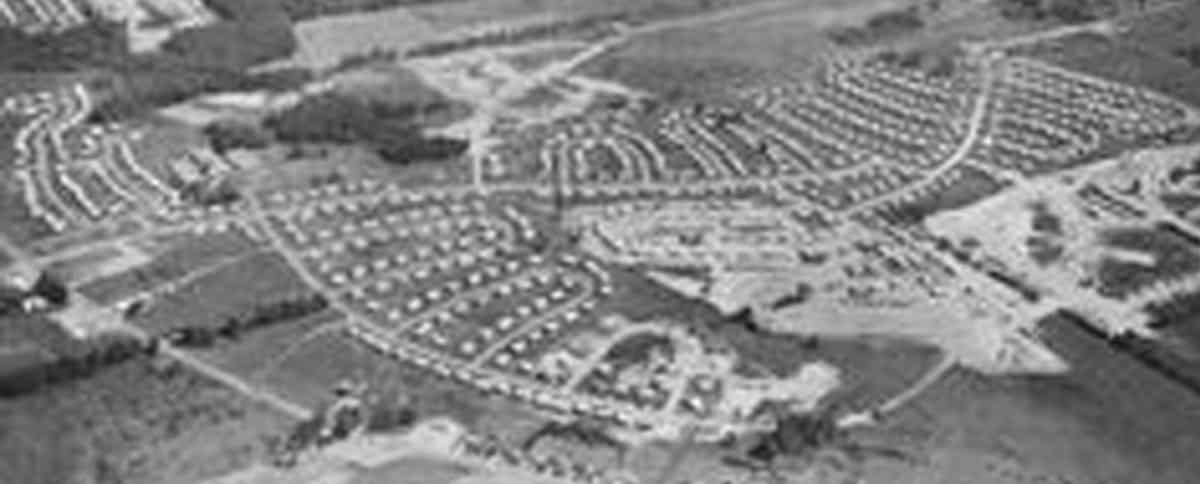The Bayberry Community is celebrating its 60th Anniversary this year! As part of our celebration, we are sharing a little of the early history of the first planned community in the Northeast. Over the next few months, we will be featuring new historical information in our newsletter, as well as here on our website. Thank you to our Historian, June Baycura, for collecting and maintaining this information over the years and sharing it with us during this incredible milestone!
Check back each month for more interesting facts about your community!
Bayberry: A look back at the beginning (Part 1)
Early in 1955, according to the Liverpool-Salina Review, the construction of arterial highways (Thruway, Route 81) was expected to dramatically impact the Liverpool area. Another impetus for home construction was the new guarantee of the federal government for GI home loans.
According to a census report, there was a dramatic increase, nationwide, in the number of couples settling in their own households. More families planned to buy houses with four or five bedrooms, near good schools.
By July 1955, surveying had begun for Bayberry, a planned community on an initial site of 475 acres purchased from the estate of James Melvin, the Zogg Farm, Howard Melvin, James Jaankowski and Mr. and Mrs. Bernard Roe. The west boundary was the Seneca River, east was Morgan Road.
In applying to a zone change of the property on behalf of Bayberry Communities, the firm of Melvin and Melvin described plans for the self-sufficient community of some 1,200 homes along an extension of Buckley Road through the community to the river. Streets were to be of a cul-de-sac or horseshoe-shaped design reducing traffic and insuring safety for children.
One school would be located on a 10-acre lot to be deeded to the school district. Commercial property would be on the perimeter for the convenience of residents. A marina would be built on the river, as well as parking area and a private sewerage treatment plant. Two swimming pools were included in the plans as well as other recreational facilities. An R-3 zoning was created for Bayberry, including parks and recreation areas, church and school buildings, as well as home and professional buildings within the community.
A look back at the beginning (Part 2)
The purchase of 475 acres by Bayberry Properties Inc. of Long Island, N.Y. was one of the largest land purchased in Onondaga County history. The internationally known architectural and planning firm of Mayer, Whittlesey and Glass would design the planned residential community, an area first.
The $23 million community would have eight different models among its 1,200 homes, ranging in price from $11,000 to $25,000. Homes were to be built in groups of 20-40. When final plans for Bayberry were announced in March of 1956, 650 acres were included in the track. This unincorporated community would be the largest in Central New York.
The comprehensive plan provided for a wide range of services, including water, storm sewers, sanitary sewers, street lighting and park districts. All streets had concrete gutters and main thoroughfares would have sidewalks.
The developers received one of the building industries most coveted prizes – a House and Home Magazine award of merit in recognition of outstanding contribution to housing progress … “a new standard of design and a new standard of livability far above anything previously available to the average family.” The award for residential design and construction was made at the convention of the National Association of Home Builders in Chicago. Other accolades in national magazines included Woman’s Home Companion featuring Bayberry in a five-page article and Mayfair designated the initial home design as its House of the Year award.
Bayberry board chairman C. Ellis Schiffmacher said that “the planning of the community in the Syracuse area indicated it will be the most beautiful community we have ever built. I know that when we begin our homes there this spring, they will achieve both national and local acclaim for value and imagination.”
Bayberry street names are a guide to each section
A number of readers have inquired about the system used for the naming of Bayberry’s streets, and there are probably many more people who are also curious about this.
Essentially, when the community was planned by the world famous architectural firm of Mayer, Whittlesey & Glass, a number of objectives were considered to be of prime importance. Among them were the elimination of four-corner intersections and the avoidance of through streets so as to disperse heavy traffic. This was done by plotting the community as a series of primary loops, technically called collecting loops, with smaller secondary loop streets.
The larger loops are known as Circles, such as Cherry Tree Circle and Bayberry Circle. The smaller street loops branching off them are known as Lanes or Paths, depending upon their locations. Each of them swings in an arc, starting and ending on the same Circle street. Therefore, the only traffic that will use these smaller streets will be heading for a specific home on that street.
In general, all of these smaller loops, which comprise the major part of Bayberry, are named according to their relationship to Buckley Road. Those to the north of Buckley Road are called Lanes and are named for fruit or berry trees, and those to the south are called Paths and are named for birds.
As a further aid in pinpointing each home, all Lanes and Paths are named in alphabetical sequence. For example, Damson Lane, Elderberry, Foxberry, etc, now follow in that order. As a result, it is rather easy for visitors to Bayberry to get their bearings. Starting at any Lane or Path, they can readily find any other Lane of Pathy by simply following the alphabetical sequence.
The six new streets of homes, which are being readied for spring construction have already been named. There will be three of each kind as Bayberry expands both east and south. The first group, to be opened in early spring, will be Egret Path, Finch Path and Gull Path. They are located off Bayberry Circle. The three tree streets, which will be the focal point of activity in the late spring, are Huckleberry Lane, Inkberry Lane and Juniper Lane.
An interesting sidelight to the choice of names is the fact that each must be checked among the various town and postal authorities to determine whether they are already being used in this area. In a few cases, there was a conflict and new names starting with the same letter had to be found.
Fun Facts
Street Names
An early map showing proposed street locations and names was eventually redesigned. But, had it remained the same, you may have been living here:
Avocado Lane = Maryland
Nettle tree = Mango
Mulberry = Limetree
Loquat = Juniper
Lemon tree = Jonquil
Zapata = Berrywood
Winterberry = Forester
Ulgx = Glenburn
Teaberry = Indian Orchard
Snowberry = Kingman
Rowenberry = Lowell
Newsletter
Communication between the board of directors and the membership-at-large has always been an important part of the BCA. The first newsletters were published by the Bayberry Corp. with articles from the residents. Later, the BCA took over with Bayberry By-Line using the old style copy machine. Not an easy undertaking. Finally, Tom Crosby, a resident and owner of the Super Duper Market (Now the Salvation Army) offered to sponsor the newsletter so that we could afford to send it to a printer. In 1964, thanks to Tom, the BCA NEWS was born. Over the years, various businesses in the community have offered sponsorship.
News From Our Past
The Big Bang
The Review, May 31, 1956
“A detonator touched in the Albany office of Federal Housing Administration district director Thomas Hannigan May 23 set off an explosive charge in Bayberry Community near Liverpool to officially start the building activity in the new 1,200 home residential development.” — “I think we are viewing a memorable moment here in Onondaga Co.,” County Board Supervisor Thomas Byer said. — “Bayberry will soon be an important part of the county map and for that reason we are thankful for the advance planning which assures us not only of well-constructed homes for its members but also provides the county with a place of beauty, an asset to our whole countryside.” — “Bayberry will include churches, a school, shopping center, a cabana club and extensive park areas. Bayberry’s model homes are expected to be open for inspection Aug. 1.”
When work began in late spring, six different models were projected – four ranch and two split levels. The community would include two miles of parks, a 10-acre shopping center, 12 acres allotted to churches and a public school, as well as a four-acre village green. A hotel and marina were projected for the Seneca River frontage.
From “The Beginnings of Bayberry”
by Hilda Watrous
During 1960, sales began to falter – attributed by some to the limitation to six designs. In May 1961, Consolidated Developers, a corporation of Syracuse businessmen, purchased the land. In the mid-60s, development halted. GE laid off 1,000 workers and many of them put their Bayberry homes up for sale. Small builders such as Caperlino and Fatti purchased some of the land and built about 500 new homes.
BCA News
June 1965
Again, as in years past, it has been brought to BCA’s attention that derogatory statements about this community have been made in isolated cases by unscrupulous real estate agents in order to lure buyers to other areas where real estate they represent is located. Real estate authorities have pledged their complete cooperation to the BCA in an effort to eliminate these malpractices.
BCA News
December 1977 by Lyn Hart, first historian
On July 4, a grand opening was staged for the sales office (now the tax office) and six model homes on Apricot Lane. The homes furnished by Chappell’s were designed specifically for the Syracuse area by Schlotz.
By May of the following year, the community had grown to 50 homes with the development of the Damson/Elderberry loop, and some houses on Blackberry Road (then Buckley Road), and Cherry Tree Circle. Utilizing the latest house designs, the builders replaced the original models with six new ones in July of 1958. These were built on Apricot and Apple Tree and subsequently on Blackberry, Bayberry Circle and the various loops adjoining Blackberry Road.
Memories of the Early Years
For the past few months, the BCA has asked residents and former residents to write in their memories growing up or living in Bayberry over the years. The following quotes reflect some individual’s life as we knew it in the young and blossoming community.
“We have many lasting friendships from our early life in Bayberry. We would ride our bikes everywhere and knew everyone along the way. We could walk to school with our friends.”
“During the summer there was lots to do—swimming and parties at the Bayberry pool and of course, there was the movie theater in the plaza. We had many street picnics on Blueberry Road. It was at our house because we could help set up and take down with our parents.”
“Our mom shopped at the bread store in the plaza. She made lunches every day for the five of us. That’s a lot of bread.”
“Bayberry was special in so many ways. We had our own school, churches and our own shopping center. Remember the Tri-R Drugstore for school supplies.”
“When our family gets together, we always say we wish our children could grow up ‘with a Bayberry community in their lives.’”
Sharon Doyle Izanzito, Scott Doyle, Bill Doyle, Brian Doyle, Barry Doyle
Bayberry – The Early Years
The following letter is from the 40th anniversary, 1996
By Tom and June McCall
We moved to Syracuse from Schenectady in September 1957, to a sales engineering assignment with the General Electric apparatus sales division. We rented for a while and searched the area for affordable housing and a safe place to raise our children.
We learned of Bayberry early on from associates at work. The reports were good: safe streets for the kids, school in near future, and future community pool.
We looked at other areas, but kept coming back to Bayberry. Its looped streets, gutters, “green” areas, etc., were innovative for that era. We were told the people were friendly and there were lots of other children to play with.
We purchased a Grant model, a three-bedroom ranch, and moved in in mid-December, 1958.
Life was never dull again!
Bayberry was a community of young people with young children. The majority were from out of the area. Bayberry had people from every state in the union. Friendships were easy to make because most people did not have local ties. Kids had plenty of kids to play with and adults had plenty of friends to party with.
Most were all in the same financial condition, so most parties were BYOB, but there was hardly a week that went by without a party – either spontaneous or planned.
The Potters, Hodgins, McClurkins, Van Houtens, Bensens, Bells, Crosbys, Alexanders, Dimitros’, Zabins, and Schaffers were just a few of the many people who lived here. Some for only a short time and others, like us, forever.
The early days meant shopping in Liverpool, Northern Lights, or Baldwinsville. Route 57 was a two-lane road. All department stores and clothing stores were located in Syracuse.
Tom Crosby, who had been store manager for the Acme Grocery Store in NOrthern Lights, opened the Crosby Super Duper on Route 57 where the Salvation Army Store is now. Opening in the early 1960s, its closeness and great service made it an instant success. On each visit, you could expect to see some of your friends and neighbors. Tom Crosby sponsored the BCA newsletter for several years.
Early on the children had to be bused to Buckley Road Elementary or into Liverpool. The village of Liverpool residents fought the construction of new schools north of the Thruway, but ultimately, the sheer growth of the area north of the Thruway with its voting power got us the Craven Crawford Elementary School. The land for the school had been deeded over to the school district when Bayberry was formed. With the new school, many children in Bayberry could walk to school.
Also in the 1960s, the Bayberry Swim Club opened, and was a smashing success. We lived on Apricot Lane, so the pool was easily accessible and our family used the pool a lot. The pool was the social center from late June to Labor Day. We had several adult parties at the pool each summer, and they were just great.
Bayberry boomed for many years. During the early years, other builders avoided the area, spoke poorly of the concept and avoided building in the area. But Bayberry’s success made many contractors rethink their position and by the mid-1960s, Camperlino and Fatti, Ryan and others began buying sections and individual lots and most of the building was completed by the early 1970s. Now it is a mature area.
Bayberry was a way of life in those early days. Everyone knew everyone. There were a lot of community doings. One of them was the annual Bayberry Community Dance. Held at the Liverpool Country Club, it was a major social event.
The Bayberry Community Association held monthly meetings. It was a political force. Meetings were well attended. The BCA was a driving force in getting the Craven Crawford Elementary School (the original name was Bayberry Elementary) built, the pool open, and getting traffic patterns improved with an opening through to Morgan Road. Initially you could only exit from Blackberry Road (then Buckley Road) onto Route 57.
We have enjoyed living in Bayberry and are coming up on 40 years as residents.
First Bayberry Yule Party A Big Success
From the Bayberry News, January 30, 1958
The party was centered around a magnificent 25-foot tree displayed in the model park area (present location of the Bayberry office building). It took a team of workers to raise it. With lights and decorations and a shining star, it was an impressive sight. Carolers soon exuded enough of the yule spirit to prompt the audience into turning the event into a community sing. To the artfully constructed manger scene came a group of “angels” singing carols, followed by Mary, Joseph, the Kings and shepherds. The climax of the party was the arrival of Santa with a bag brimming over with candy and other attractions. While the children enjoyed their gifts, refreshments were served to the adults at the sales office (now the tax office). A note of special appreciation was earned by the entertainment chairperson of the BCA.


